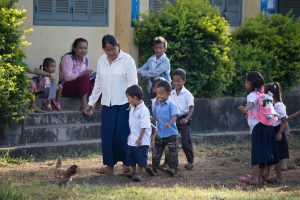
សាលាបឋមសិក្សាជីផាត ខេត្តកោះកុង។ រូបភាពដោយ ក្រុមការងារអូឌីស៊ី ថតនៅថ្ងៃទី២៨ ខែវិច្ឆិកា ឆ្នាំ២០១៧។ ក្រោមអាជ្ញាប័ណ្ណ CC BY-SA 4.0.
ការទទួលបានការអប់រំមួយ ដែលមានគុណភាព និងឥតគិតថ្លៃ គឺជាសិទ្ធិដែលមានចែងនៅក្នុងរដ្ឋធម្មនុញ្ញនៃព្រះរាជាណាចក្រកម្ពុជា។
- មាត្រា៦៥៖ “រដ្ឋត្រូវការពារ និង លើកស្ទួយសិទ្ធិរបស់ប្រជាពលរដ្ឋ ក្នុងការទទួលបានការអប់រំមួយប្រកបដោយគុណភាព នៅគ្រប់កម្រិត និង ត្រូវចាត់វិធានការគ្រប់បែបយ៉ាង ជាជំហានៗ ដើម្បីឱ្យការអប់រំនេះបានទៅដល់ប្រជាពលរដ្ឋគ្រប់រូប …”។
- មាត្រា៦៦៖ “រដ្ឋកសាងប្រព័ន្ធអប់រំមួយពេញលេញ និង ឯកភាពនៅទូទាំងប្រទេស ដែលធានាឱ្យបាននូវគោលការណ៍សេរីភាពខាងសិក្សាធិការ និង គោលការណ៍សមភាពក្នុងការអប់រំ …”។
- មាត្រា៦៧៖ “… រដ្ឋគ្រប់គ្រងគ្រឹះស្ថានសិក្សា និងថ្នាក់សិក្សាសាធារណៈ និងឯកជននៅគ្រប់ភូមិសិក្សា”។
- មាត្រា៦៨៖ “រដ្ឋផ្តល់កិច្ចការអប់រំផ្នែកបឋម និង មធ្យមសិក្សានៅសាលារៀនសាធារណៈសម្រាប់ប្រជាពលរដ្ឋគ្រប់រូប ដោយឥតបង់ថ្លៃ។ ប្រជាពលរដ្ឋ ត្រូវបានទទួលការអប់រំយ៉ាងតិច៩ឆ្នាំ …”។ 1
អត្រាការចុះឈ្មោះចូលរៀនរបស់កុមារនៅថ្នាក់បឋមសិក្សា នៅប្រទេសកម្ពុជា កំពុងតែកើនឡើងជិតដល់១០០%។ ចំណាយរបស់រាជរដ្ឋាភិបាលលើវិស័យអប់រំ បានកើនឡើងជាបន្តបន្ទាប់ ក្នុងរយៈពេលប៉ុន្មានឆ្នាំចុងក្រោយនេះ។ សាលារៀនថ្មីៗជាច្រើនត្រូវបានបង្កើតឡើង ហើយអត្រាអក្ខរកម្មត្រូវបានលើកកម្ពស់។ ប៉ុន្តែទោះបីជាផ្នែកខ្លះនៃវិស័យអប់រំបានអភិវឌ្ឍទៅមុខយ៉ាងឆាប់រហ័សក៏ដោយ បញ្ហាប្រឈមមួយចំនួននៅតែកើតមានឡើង។
ផែនការយុទ្ធសាស្ត្រអភិវឌ្ឍន៍ជាតិឆ្នាំ ២០១៤-២០១៨ បានដាក់ចេញជាភាសាសាមញ្ញថា “វិស័យអប់រំមានភាពយឺតយ៉ាវ ដែលតម្រូវឱ្យមានការកែលម្អ ។ បញ្ហាចម្បងៗរួមមាន គុណភាពសិក្សានៅមានកម្រិត កង្វះខាតបរិក្ខារសិក្សា កង្វះខាតគ្រូបង្រៀនដែលមានសមត្ថភាព ភាពខ្វះចន្លោះនៃការអនុវត្តប្រព័ន្ធធានាគុណភាពសិក្សា និងចំនួនតិចតួចនៃគ្រឹះស្ថានឧត្តមសិក្សាដែលមានគុណភាព”។2
បញ្ហាប្រឈមមួយចំនួនគិតជាលេខ៖
- កម្ពុជា ជាប្រទេសដែលមានផលធៀបសិស្ស-គ្រូទាបជាងគេបំផុតនៅក្នុងតំបន់អាស៊ាន ដែលមានគ្រូបង្រៀនម្នាក់ សម្រាប់សិស្សចំនួន ៤៣នាក់ ក្នុងសាលាបឋមសិក្សា។3
- ទោះបីជាអត្រានៃការចុះឈ្មោះចូលរៀននៅថ្នាក់បឋមសិក្សាបានកើនឡើងជិតដល់ ១០០% ក៏ដោយ វត្តមានសិក្សា និងការបញ្ចប់ការសិក្សា នៅតែស្ថិតក្នុងកម្រិតទាបគួរឱ្យកត់សំគាល់។ ការសិក្សាមួយបានបង្ហាញថា មានតែ ៨១% នៃកុមារី និង៨៣% នៃកុមារា ដែលមានអាយុចាប់ពី ៦ ទៅ ១១ឆ្នាំ បានកំពុងសិក្សានៅថ្នាក់បឋមសិក្សា។4 តួលេខមួយចំនួនបានបង្ហាញពីការធ្លាក់ចុះនៃការអប់រំ ដូចជាការបញ្ចប់ការសិក្សានៅថ្នាក់បឋមសិក្សាបានធ្លាក់ចុះមកត្រឹម ៨០,៦% នៅឆ្នាំ ២០១៥ បើធៀបទៅនឹងឆ្នាំកន្លងទៅ ដែលមានរហូតដល់ ៨៤%។ ដូចគ្នានេះដែរ គេរកឃើញថា ចំនួនកុមារ ដែលបានបញ្ចប់ថ្នាក់បឋមសិក្សាមានតិចជាង ៨០% នៅស្រុកចំនួន៩ទៀត។5
កម្មវិធីអប់រំកុមារតូច
រាជរដ្ឋាភិបាលបានទទួលស្គាល់ពីសារៈសំខាន់នៃកម្មវិធីអប់រំកុមារតូច ដែលមានអាយុចាប់ពី ៣ ទៅ ៥ឆ្នាំ។ កុមារដែលមានអាយុ ៥ឆ្នាំ មានអត្រាការចូលរៀនខ្ពស់បំផុត ដោយកើនឡើងពី ៣៥% នៅឆ្នាំ ២០០៨-២០០៩ ទៅ ៦៤% នៅឆ្នាំ ២០១៤-២០១៥។6 យ៉ាងណាក៏ដោយ មានតែកុមារ ១នាក់ ក្នុងចំណោម ៥នាក់ ដែលមានអាយុបីឆ្នាំ និងកុមារ ១នាក់ក្នុងចំណោម ៣នាក់ ដែលមានអាយុ៤ឆ្នាំ បានទទួលកម្មវិធីអប់រំកុមារតូច។ តួលេខនេះ មានកម្រិតទាបខ្លាំង ជាពិសេសនៅតាមតំបន់ដាច់ស្រយាល ដូចជាកុមារមកពីគ្រួសារក្រីក្រ ឬជនជាតិដើមភាគតិច និងកុមារពិការ។ 7 នេះបង្ហាញថា តិចជាង ១ភាគ៣ នៃកុមារដែលមានអាយុ ៣ ទៅ ៥ឆ្នាំ បានទទួលជំនាញដែលពួកគេគួរមាន ដូចជាការអាន និងរាប់លេខ។
ការអប់រំបឋមសិក្សា និងមធ្យមសិក្សា
រាជរដ្ឋាភិបាលកំពុងតែខិតខំប្រឹងប្រែងដើម្បីឱ្យកុមារកម្ពុជា ទទួលបានការអប់រំយ៉ាងតិចត្រឹមថ្នាក់ទី៩ ដូចអ្វីដែលបានចែងក្នុងរដ្ឋធម្មនុញ្ញ។ បើតាមបច្ចេកទេស កុមារម្នាក់អាចបញ្ចប់ការសិក្សា រយៈពេល១២ឆ្នាំ៖ ក្នុងនោះរួមមាន៦ឆ្នាំ នៅកម្រិតបឋមសិក្សា (ចាប់ពីថ្នាក់ទី១ ដល់ទី៦) ៣ឆ្នាំ នៅកម្រិតអនុវិទ្យាល័យ (ចាប់ពីថ្នាក់ទី៧ ដល់ទី៩) និង៣ឆ្នាំ ទៀត សម្រាប់កម្រិតវិទ្យាល័យ (ចាប់ពីថ្នាក់ទី១០ ដល់ទី១២)។
អត្រានៃការចុះឈ្មោះចូលរៀនសម្រាប់ឆ្នាំសិក្សា ២០១៦-២០១៧ មានចំនួន ៩៣,៥%សម្រាប់បឋមសិក្សា និង៥៥,៧% សម្រាប់អនុវិទ្យាល័យ និង២៥,១% នៅវិទ្យាល័យ។8
តួលេខរបស់រាជរដ្ឋាភិបាលបានបង្ហាញថា ជារៀងរាល់ឆ្នាំនៅថ្នាក់បឋមសិក្សា មានសិស្ស៦,៦% រៀនត្រួតថ្នាក់ និងសិស្ស៤,៦% បោះបង់ការសិក្សា។ ចំពោះកម្រិតអនុវិទ្យាល័យវិញ មានសិស្ស ២,៨% រៀនត្រួតថ្នាក់ជារៀងរាល់ឆ្នាំ និង១៩,៤% បោះបង់ការសិក្សាចោល។9
អត្រានៃសិស្សបញ្ចប់ការសិក្សាបានធ្លាក់ចុះយ៉ាងខ្លាំងជាបន្តបន្ទាប់ ក្រោយកម្រិតបឋមសិក្សា៖ ចាប់ពី ៧៩,៩% នៅកម្រិតបឋមសិក្សា មកត្រឹម ៤២,៦% នៅកម្រិតអនុវិទ្យាល័យ និងបន្តធ្លាក់ចុះត្រឹមតែ ២០,២% នៅកម្រិតវិទ្យាល័យ។10 នៅទូទាំងប្រទេស %នៃការបញ្ចប់ការសិក្សានៅបឋមសិក្សារបស់កុមារី មាន%ខ្ពស់ជាងកុមារា ពោលគឺ ៨៣,២% ធៀបនឹង ៧៦,១%។11 អត្រានៃការបញ្ចប់សិក្សាតាមយេនឌ័រនេះ ក៏មានភាពខុសគ្នានៅកម្រិតវិទ្យាល័យ និងអនុវិទ្យាល័យ។
ការស្រាវជ្រាវនៅឆ្នាំ២០១២បានបង្ហាញថា បើទោះបីជាសាលារដ្ឋផ្តល់ការសិក្សាដោយឥតបង់ថ្លៃ ដូចប្រទេសឯទៀតក៏ដោយ អាណាព្យាបាល និងសិស្សមួយចំនួនបាននិយាយថា ពួកគេនៅតែបង់ថ្លៃសិក្សាដដែល។12 គេប៉ាន់ស្មានថា សម្រាប់សិស្សម្នាក់ៗ ត្រូវចំណាយប្រហែលជា ១១៩ ដុល្លារសហរដ្ឋអាមេរិក ក្នុងមួយឆ្នាំ ដែលវាជាចំនួនច្រើនសម្រាប់គ្រួសារមានចំនូលទាប និងគ្រួសារដែលមានកូនក្នុងវ័យសិក្សាច្រើននាក់។ ការចំណាយនេះក៏អាចជះឥទ្ធិពលលើការបោះបង់ការសិក្សាផងដែរ។
គ្រឹះស្ថានសិក្សា និងស្ថានភាពរបស់សាលា
ប្រទេសកម្ពុជាមានសាលារៀនចំនួន ១២ ៨៨៩ (សាលាបឋមសិក្សាមានចំនួន ៧១៤៤) ក្នុងឆ្នាំសិក្សា ២០១៦ -២០១៧។13 បើធៀបនឹងឆ្នាំ២០១៣ មានសាលាចំនួន ១៥១៩ កើនឡើង។14
ថ្វីត្បិតតែមានការសាងសង់បរិក្ខារប្រើប្រាស់ក្នុងសាលារៀនទូទាំងប្រទេស តែគុណភាពនៅមានកម្រិត។ ជាឧទាហរណ៍ ៤០,៩% នៃសាលាបឋមសិក្សា និង ៥៣,៧% នៃវិទ្យាល័យ ពុំមានទឹកប្រើប្រាស់ទេ។15 យោងតាមរបាយការណ៍ឆ្នាំ២០១៧ របស់ក្រសួង អប់រំ យុវជន និងកីឡា សាលាបឋមសិក្សាចំនួន ១៤,១% និងវិទ្យាល័យ ៩% ពុំមានបង្គន់អនាម័យប្រើប្រាស់នោះទេ។16 ស្ថានភាពសាលារៀននៅតាមទីក្រុង និងនៅជនបទគឺមិនខុសគ្នាប៉ុន្មានទេ។ វត្តអារាម បានដើរតួនាទីយ៉ាងសំខាន់នៅក្នុងវិស័យអប់រំ។ ទិន្នន័យរបស់ក្រសួងអប់រំបានបង្ហាញថា មានសាលារៀនចំនួន ១០៣០ ស្ថិតនៅក្នុងបរិវេណវត្តអារាម។17
ថវិកាសំរាប់ការអប់រំ និងការបណ្តុះបណ្តាលវិជ្ជាជីវៈគ្រូបង្រៀន
ដ្ឋមន្ត្រី ក្រសួងអប់រំ លោក ហង់ ជួនណារ៉ុន បានមានប្រសាសន៍ថា ”ការជ្រើសរើសគ្រូបង្រៀនឱ្យបានគ្រប់គ្រាន់ គឺជាបញ្ហាប្រឈមដ៏ធំនៅក្នុងប្រទេសកម្ពុជា។ ដើម្បីដោះស្រាយបញ្ហានេះ យើងត្រូវបង្កើនខ្ទង់ចំណាយទៅលើ វិស័យអប់រំ ដើម្បីផ្តល់ប្រាក់ខែសមរម្យ និងរក្សាបាននូវចំនួនគ្រូបង្រៀនដែលមានសមត្ថភាពខ្ពស់។18
គ្រូបង្រៀនប្រមាណ ១៨ ០០០ នាក់ បានបញ្ចប់ការសិក្សាថ្នាក់មហាវិទ្យាល័យ។ គ្រូបង្រៀន ដែលមានកម្រិតសិក្សាថ្នាក់វិទ្យាល័យ មានចំនួន ៥១ ៨២០ នាក់ ឯគ្រូបង្រៀន ១៩ ២៦៧ នាក់ទៀតមានកម្រិតសិក្សាថ្នាក់អនុវិទ្យាល័យ ហើយមានតែគ្រូបង្រៀនចំនួន ១ ៧៧៩ នាក់ប៉ុណ្ណោះដែលបានសិក្សាត្រឹមបឋមសិក្សា។19
អង្គការយូណេស្កូ បានផ្តល់ជាអនុសាសន៍ទៅរាជរដ្ឋាភិបាល ឱ្យចំណាយយ៉ាងតិច ២០%នៃថវិកាជាតិទៅលើវិស័យអប់រំ ហើយខ្ទង់ចំណាយរបស់ក្រសួងអប់រំ ក៏កំពុងឈានទៅដល់តួលេខដែលបានណែនាំនោះដែរ។ នៅក្នុងឆ្នាំ២០១៤ ការចំណាយលើវិស័យអប់រំ មានចំនួន ៣៣៥ លានដុល្លារសហរដ្ឋអាមេរិក ដែលមានចំនួនតិចជាង ១០% នៃថវិកាជាតិ។ ចំនួនថវិកាដែលបានស្នើ សម្រាប់វិស័យអប់រំក្នុងឆ្នាំ២០១៨ គឺមានចំនួន ៨៤៨លានដុល្លារសហរដ្ឋអាមេរិក ប្រហែលជា ១៤% នៃថវិកាជាតិសរុប។20
ប្រាក់បៀវត្សន៍របស់គ្រូបង្រៀន បានកើនឡើងគួរឱ្យកត់សំគាល់ក្នុងប៉ុន្មានឆ្នាំចុងក្រោយនេះ ប៉ុន្តែចាប់ផ្តើមចេញពីកម្រិតដំបូង។ នៅដើមឆ្នាំ២០១៤ បៀរវត្សទាបបំផុតសម្រាប់គ្រូបង្រៀនគឺ ៨០ដុល្លារសហរដ្ឋអាមេរិក ក្នុងមួយខែ។21 នៅខែមេសា ឆ្នាំ ២០១៧ ប្រាក់បៀរវត្សន៍បានកើនដល់ ២៣០ ដុល្លារសហរដ្ឋអាមេរិក (មិនទាន់រួមបញ្ចូលប្រាក់អត្ថប្រយោជន៍ផ្សេងទៀត)។22
នៅឆ្នាំ ២០២០ ក្រសួងអប់រំ មានផែនការ បង្កើនកម្រិតអប់រំរបស់គ្រួបង្រៀនយ៉ាងតិចត្រឹមថ្នាក់ទី៩ បូករួមទាំងការចូលរួមវគ្គបណ្តុះបណ្តាលវិជ្ជាជីវៈ ២ឆ្នាំ នៅថ្នាក់ខេត្ត រហូតដល់ ថ្នាក់ទី១២ រួមទាំង៤ឆ្នាំបន្ថែមលើវគ្គបណ្តុះបណ្តាលវិជ្ជាជីវៈ។23
អក្ខរកម្ម
អត្រាអក្ខរកម្មក្នុងចំណោមយុវជន ដែលមានអាយុពី១៥ ទៅ២៤ឆ្នាំ មានចំនួន ៩២,២% ក្នុងឆ្នាំ២០១៥ ដែលកើនឡើង ៤% ធៀបនឹងឆ្នាំ២០០៨។24
របាយការណ៍ស្ទង់មតិសង្គម-សេដ្ឋកិច្ចកម្ពុជា នៅឆ្នាំ២០១៥ បង្ហាញថាអត្រាអក្ខរកម្មរបស់មនុស្សពេញវ័យមានចំនួន ៨០,៥% ។25
អត្រាខ្ពស់នៃការចំណាកស្រុកដោយសារការស្វែងរកការងារ បានជះឥទ្ធិពលដល់ការទទួលបានការអប់រំរបស់យុវជន។ ប្រជាជនមិនចេះអក្សរភាគច្រើន ធ្វើការក្នុងរោងចក្រ ដែលជះឥទ្ធិពលដល់ការតាំងចិត្តក្នុងការសិក្សាពេលល្ងាច។
ការអប់រំថ្នាក់ឧត្តមសិក្សា
ចំណុចខ្សោយនៃវិស័យឧត្តមសិក្សា និងបណ្តុះបណ្តាលរបស់ប្រទេសកម្ពុជា គឺត្រូវបានមើលឃើញយ៉ាងច្បាស់ ក្នុងសន្ទស្សន៍ប្រកួតប្រជែងពិភពលោក (GCI) ឆ្នាំ២០១៧-២០១៨ ដែលស្ថិតក្នុងលំដាប់ទី១២៤ ក្នុងចំណោមប្រទេស១៣៧។26
ក្រសួងអប់រំយុវជន និងកីឡា បានចេញឯកសារគោលនយោបាយ ស្តីពីចក្ខុវិស័យសម្រាប់ការអប់រំថ្នាក់ឧត្តមសិក្សា ឆ្នាំ២០៣០ នៅក្នុងខែមេសា២០១៤។27
ការអប់រំថ្នាក់ឧត្តមសិក្សា មានសារៈសំខាន់ណាស់ចំពោះការអភិវឌ្ឍជាតិ។ ឯកសារគោលនយោបាយនេះ បានដាក់ចេញនូវផែនការយុទ្ធសាស្ត្រ និងសកម្មភាពក្នុងការអនុវត្តគោលដៅនេះ ដែលផ្តោតលើការទទួលបាន និងគុណភាពនៃការអប់រំ ព្រមទាំងកម្មវិធីសិក្សាដែលបំពេញតម្រូវការទីផ្សារការងារបច្ចុប្បន្ន និងការអភិវឌ្ឍ។
បញ្ហាប្រឈមដ៏សំខាន់នៃការអប់រំថ្នាក់ឧត្តមសិក្សា ដែលបានលើកឡើងនៅក្នុងឯកសារនោះគឺភាគច្រើនសិស្សនិយមសិក្សាមុខវិជ្ជាជំនួញ ហើយអ្នកដែលជ្រើសរើសយកមុខជំនាញមួយចំនួនដូចជា វិទ្យាសាស្ត្រ វិស្វកម្ម និងកសិកម្ម គឺមានតិចតួចណាស់។ ឯកសារនេះបានបញ្ជាក់ថា មុខជំនាញដែលគេមិនសូវចាប់អារម្មណ៍ទាំងនោះ គឺជាផ្នែកមួយដែលដើរតួសំខាន់សម្រាប់កំណើនសេដ្ឋកិច្ចរបស់កម្ពុជា”។28
ផែនការអនាគត
ក្រសួងអប់រំ យុវជន និងកីឡា បានធ្វើការឆ្លើយតបទៅនឹងលទ្ធផល ដែលបានរំពឹងទុកនៅក្នុងផែនការយុទ្ធសាស្ត្រវិស័យអប់រំឆ្នាំ ២០១៤-២០១៨ តាមរយៈការរៀបចំផែនការយុទ្ធសាស្ត្រអប់រំឆ្នាំ ២០១៤-២០១៨។29 សកម្មភាពនេះបានបង្កើនការយកចិត្តទុកដាក់ទៅលើ ការពង្រីកបន្ថែមការអប់រំកុមារតូច ការលើកកម្ពស់លទ្ធភាពក្នុងការទទួលបានការអប់រំនៅមធ្យមសិក្សា និងក្រោយមធ្យមសិក្សា និងការអប់រំក្រៅប្រព័ន្ធ មានដូចជាការអប់រំបច្ចេកទេស និងវិជ្ជាជីវៈមួយ ដែលមានគុណភាព។ វិធានការជាក់លាក់មួយចំនួន នឹងត្រូវបានអនុវត្តដើម្បីធានាថាកុមារ និងយុវជនដែលងាយរងគ្រោះនឹងទទួលបានការអប់រំដូចគ្នា។
នៅខែមករា ឆ្នាំ២០១៦ រាជរដ្ឋាភិបាលបានដាក់ចេញនូវគោលនយោបាយជាតិសម្រាប់ការអភិវឌ្ឍកុមារ ហើយនឹងត្រូវត្រួតពិនិត្យដោយក្រុមប្រឹក្សាជាតិដើម្បីកុមារ។30 គោលនយោបាយ នេះមានគោលបំណងកាត់បន្ថយអត្រាបោះបង់ចោលការសិក្សា និងបង្កើនឱកាសបណ្តុះបណ្តាលវិជ្ជាជីវៈ ក្នុងចំណោមបញ្ហាជាច្រើនទៀត។
ធ្វើបច្ចុប្បន្នភាព៖ ០២ មេសា ២០១៨
ទាក់ទងនឹងការអប់រំ និងការបណ្តុះបណ្តាល
ឯកសារយោង
- 1. អគ្គលេខាធិការដ្ឋានព្រឹទ្ធសភា (២០០៨)។ “រដ្ឋធម្មនុញ្ញនៃព្រះរាជាណាចក្រកម្ពុជា”។ ចូលអានថ្ងៃទី១៦ ខែកុម្ភៈ ឆ្នាំ ២០១៨។
- 2. រាជរដ្ឋាភិបាលកម្ពុជា(២០១៤)។ “ផែនការយុទ្ធសាស្ត្រអភិវឌ្ឍន៍ជាតិ ២០១៤- ២០១៨”។ ចូលអានថ្ងៃទី ១៦ ខែកុម្ភៈ ឆ្នាំ២០១៨។
- 3. ក្រសួងអប់រំ យុវជន និងកីឡា (២០១៧)។ “ស្ថិតិ និងសូចនាករអប់រំសាធារណៈ ឆ្នាំសិក្សា ២០១៦-២០១៧”។ ចូលអានថ្ងៃទី ១៦ ខែកុម្ភៈ ឆ្នាំ២០១៨។
- 4. អង្គការទស្សនៈពិភពលោក (២០១៧)។ “ការអប់រំ-សង្ខេបគោលនយោបាយ ឆ្នាំ ២០១៧”។ ចូលអានថ្ងៃទី ១៦ ខែកុម្ភៈ ឆ្នាំ២០១៨។
- 5. ដូចឯកសារយោងខាងលើ
- 6. ដូចឯកសារយោងខាងលើ
- 7. ដូចឯកសារយោងខាងលើ
- 8. កាសែតភ្នំពេញប៉ុស្តិ៍។ ”អក្ខរកម្មជាគោលដៅមួយ ក្នុងចំណោមគោលដៅអភិវឌ្ឍន៍ប្រកបដោយនិរន្តរភាព”។ ចុះថ្ងៃទី ១១ ខែកញ្ញា ២០១៧។ ចូលអានថ្ងៃទី១៦ ខែកុម្ភៈ ឆ្នាំ២០១៨។
- 9. ក្រសួងអប់រំ យុវជន និងកីឡា (២០១៧)។ “ស្ថិតិ និងសូចនាករអប់រំសាធារណៈ ឆ្នាំសិក្សា ២០១៦-២០១៧”។ ចូលអានថ្ងៃទី ១៦ ខែកុម្ភៈ ឆ្នាំ២០១៨។
- 10. ដូចឯកសារយោងខាងលើ
- 11. ដូចឯកសារយោងខាងលើ
- 12. អង្គការទស្សនៈពិភពលោក (២០១៧)។ “ការអប់រំ-សង្ខេបគោលនយោបាយ ឆ្នាំ ២០១៧”។ ចូលអានថ្ងៃទី១៦ ខែកុម្ភៈ ឆ្នាំ២០១៨។
- 13. ក្រសួងអប់រំ យុវជន និងកីឡា (២០១៧)។ “ស្ថិតិ និង សូចនាករអប់រំសាធារណៈ ឆ្នាំសិក្សា ២០១៦-២០១៧”។ ចូលអានថ្ងៃទី១៦ ខែកុម្ភៈ ឆ្នាំ២០១៨។
- 14. ថាច់ ផាណារ៉ុង។ “រដ្ឋមន្ត្រីក្រសួងអប់រំ៖ កម្ពុជាមានសាលាចំនួន ១១ ៣៧០”។ ទីភ្នាក់ងារសារព័ត៌មានកម្ពុជា, ចុះថ្ងៃទី ១៩ ខែមីនា ឆ្នាំ២០១៣។ ចូលអានថ្ងៃទី ១៦ ខែកុម្ភៈ ឆ្នាំ២០១៨។
- 15. ក្រសួងអប់រំ យុវជន និងកីឡា (២០១៧)។ “ស្ថិតិ និង សូចនាករអប់រំសាធារណៈ ឆ្នាំសិក្សា ២០១៦-២០១៧”។ ចូលអានថ្ងៃទី១៦ ខែកុម្ភៈ ឆ្នាំ២០១៨។
- 16. ដូចឯកសារយោងខាងលើ
- 17. ដូចឯកសារយោងខាងលើ
- 18. Laignee Barron។ “បទយកការណ៍៖ ការចុះឈ្មោះចូលរៀន គ្រាន់តែជាការចាប់ផ្តើម”។ កាសែតភ្នំពេញប៉ុស្តិ៍, ចុះថ្ងៃទី ០៧ ខែមីនា ឆ្នាំ២០១៧។ ចូលអានថ្ងៃទី ១៦ ខែកុម្ភៈ ឆ្នាំ២០១៨។
- 19. ក្រសួងអប់រំ យុវជន និងកីឡា (២០១៧)។ “ស្ថិតិ និង សូចនាករអប់រំសាធារណៈ ឆ្នាំសិក្សា ២០១៦-២០១៧”។ ចូលអានថ្ងៃទី១៦ ខែកុម្ភៈ ឆ្នាំ២០១៨។
- 20. បែន សុខហ៊ាន។ “រដ្ឋាភិបាលបានស្នើថវិកាចំនួន ៦ ពាន់លានដុល្លារ សម្រាប់ឆ្នាំ ២០១៨”។ កាសែតភ្នំពេញប៉ុស្តិ៍, ចុះថ្ងៃទី៣០ ខែតុលា ឆ្នាំ២០១៧។ ចូលអានថ្ងៃទី ១៦ ខែកុម្ភៈ ឆ្នាំ២០១៨។
- 21. ឃុត សុភចរិយា។ “បាតុកម្មរបស់គ្រួបង្រៀន ផ្តល់មេរៀនដ៏ល្អមួយសម្រាប់រាជរដ្ឋាភិបាល”។ កាសែតភ្នំពេញប៉ុស្តិ៍, ចុះថ្ងៃទី០៨ ខែមករា ឆ្នាំ២០១៤។ ចូលអានថ្ងៃទី ១៦ ខែកុម្ភៈ ឆ្នាំ២០១៨។
- 22. ប៉ិច សុធារី។ “ប្រាក់រាជរដ្ឋាភិបាល៖ ប្រាក់ខែគ្រូបង្រៀននៅខែមេសា ឆ្នាំ២០១៧ នឹងឡើងដល់ជាង ៩៥ម៉ឺនរៀល”។ កាសែតខ្មែរថាមស៍, ចុះថ្ងៃទី ០៤ ខែតុលា ឆ្នាំ២០១៦។ ចូលអានថ្ងៃទី ១៦ ខែកុម្ភៈ ឆ្នាំ២០១៨។31
គ្រូបង្រៀនជាជនជាតិជនបរទេសជាច្រើនកំពុងបង្រៀនភាសាអង់គ្លេសនៅកម្ពុជា ជាពិសេសនៅសាលាឯកជន ដែលជាចំណែកមួយនៃបញ្ហានេះដែរ។ ប្រាក់បៀវត្ស ជាមធ្យម សម្រាប់តួនាទីនេះនៅភ្នំពេញគឺ រវាង ១០ ទៅ ១៤ ដុល្លារសហរដ្ឋអាមេរិក ក្នុង១ម៉ោង។32Richelle Gamlam។ “ប្រាក់ខែរំពឹងទុកសម្រាប់ការបង្រៀនភាសាអង់គ្លេសនៅកម្ពុជា”។ Gooverseas, ចុះថ្ងៃទី ១៤ ខែមេសា ២០១៥។ ចូលអានថ្ងៃទី ១៦ ខែកុម្ភៈ ឆ្នាំ២០១៨។
- 23. Laignee Barron។ “បទយកការណ៍៖ ការចុះឈ្មោះចូលរៀន គ្រាន់តែជាការចាប់ផ្តើម”។ កាសែតភ្នំពេញប៉ុស្តិ៍, ចុះថ្ងៃទី ០៧ ខែមីនា ឆ្នាំ២០១៧។ ចូលអានថ្ងៃទី ១៦ ខែកុម្ភៈ ឆ្នាំ២០១៨។
- 24. បុគ្គលិកភ្នំពេញប៉ុស្តិ៍។ “អក្ខរកម្មជាគោលដៅមួយ ក្នុងចំណោមគោលដៅអភិវឌ្ឍន៍ប្រកបដោយនិរន្តរភាព”។ កាសែតភ្នំពេញប៉ុស្តិ៍, ចុះថ្ងៃទី ១១ ខែកញ្ញា ២០១៧។ ចូលអានថ្ងៃទី១៦ ខែកុម្ភៈ ឆ្នាំ២០១៨។
- 25. ដូចឯកសារយោងខាងលើ
- 26. វេទិកាសេដ្ឋកិច្ចពិភពលោក (WEF) (២០១៧)។ “របាយការណ៍ស្ដីពីសន្ទស្សន៍ប្រកួតប្រជែងពិភពលោក (GCI) ឆ្នាំ ២០១៧-២០១៨”។ ចូលអានថ្ងៃទី ១៦ ខែកុម្ភៈ ឆ្នាំ២០១៨។
- 27. ក្រសួងអប់រំ យុវជន និងកីឡា (២០១៤)។ “គោលនយោបាយស្តីពី ចក្ខុវិស័យឧត្តមសិក្សា ២០៣០”។ ចូលអានថ្ងៃទី ១៦ ខែកុម្ភៈ ឆ្នាំ២០១៨។
- 28. ដូចឯកសារយោងខាងលើ
- 29. ក្រសួងអប់រំ យុវជន និងកីឡា (២០១៤)។ “ផែនការយុទ្ធសាស្ត្រវិស័យអប់រំ ឆ្នាំ២០១៤-២០១៨”។ ចូលអានថ្ងៃទី ១៦ ខែកុម្ភៈ ឆ្នាំ២០១៨។
- 30. Igor Kossov។ “ការសម្ពោធគម្រោងសុខុមាលភាពកុមារ”។ កាសែតភ្នំពេញប៉ុស្តិ៍, ចុះថ្ងៃទី ២១ ខែមករា ឆ្នាំ២០១៦។ ចូលអានថ្ងៃទី ១៦ ខែកុម្ភៈ ឆ្នាំ២០១៨។

